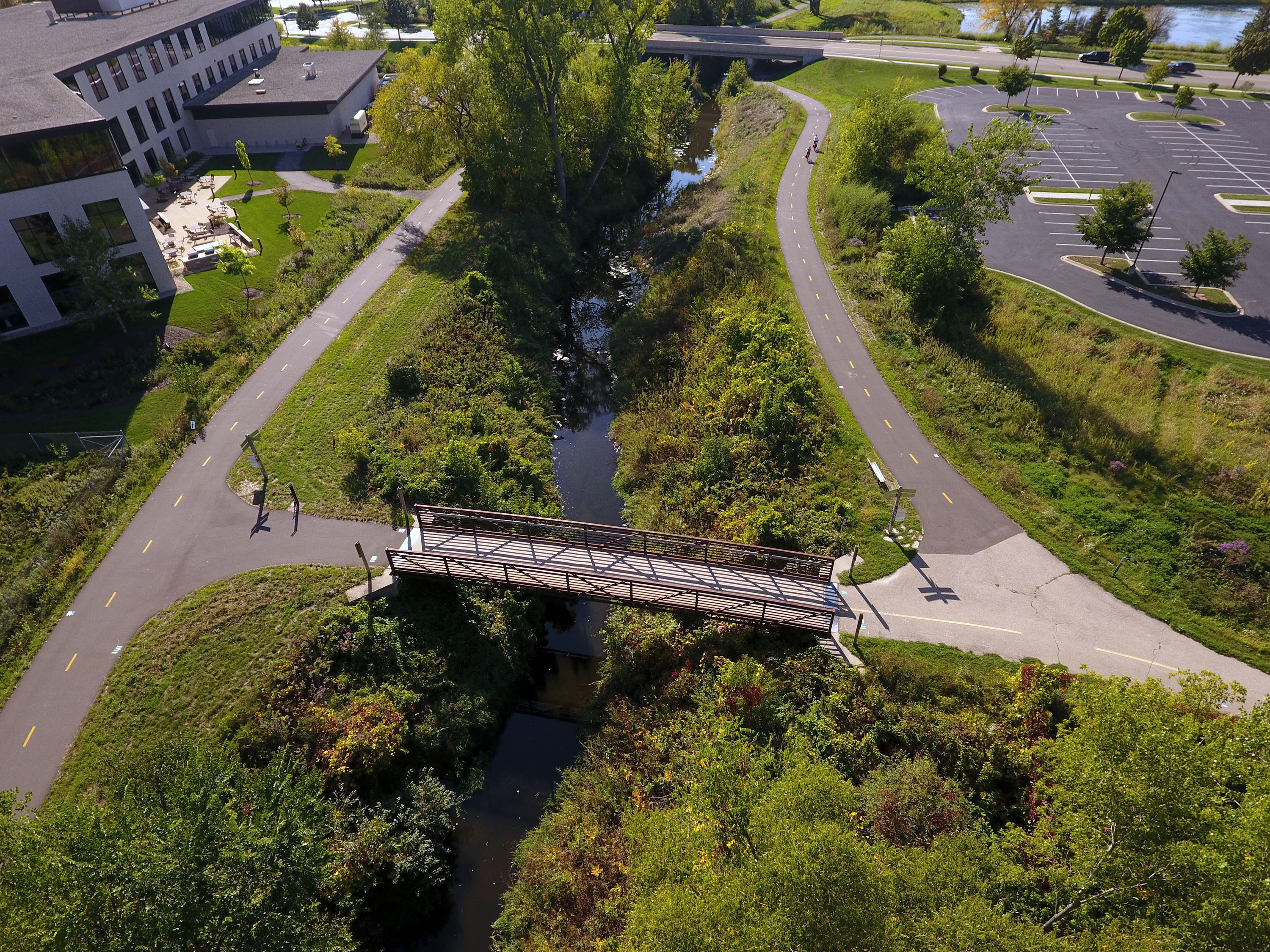Middleton Flood Restoration Project: Resilient, Inclusive, Protective Design
 Written by: Raine Gardner, PE
Written by: Raine Gardner, PE
![]()
In 2018, the City of Middleton and surrounding area received 11-15 inches of rain in a 12-hour period, exceeding NOAA’s 1,000-year flood event statistic by almost 4 inches. Flooding impacted all facets of community infrastructure including the region’s beloved Pheasant Branch Creek corridor which required an estimated $2.5 million to restore. Streambanks were severely eroded, the creek forged new channels, six wooded pedestrian bridges were damaged or fully relocated, over 250 trees were downed, fiber optic line exposed, and the pedestrian trail almost entirely washed out.
Reimaging Bridge Design
MSA provided design engineering and construction observation services for the reconstruction of the 1.7-mile Pheasant Branch Creek Corridor Trail and six (6) pedestrian bridges that had been damaged in the 2018 storm. Work began by evaluating soil borings, topographic survey results, performing HEC-RAS floodplain modeling, and conducting a thorough hydraulic analysis. It was determined that the original base pan foundations of the bridges had been greatly undermined by scour and needed a more robust, sustainable solution. This was a challenge due to the extremely sandy nature of the creek soils, so engineers utilized a helical pile system consisting of steel screw-like components approximately seven (7) feet long, affixed vertically to one another to reach the requisite length/depth. Each pile was driven 20-50 feet below grade to transfer the compression loads of the bridges to a more competent soil strata beneath the sand. A concrete U-shaped abutment was then installed on top of the pilings.
Many of the bridge superstructures (steel trusses, wood decking and railings) were found to be in reasonable condition and could be repurposed — saving the community critical funding — but the bridges did not maintain an adequate freeboard distance, so MSA engineers raised the full elevation of each bridge 1.5 to 4.5 feet to establish more flood capacity and better protect the bridges.
Modernizing Trail Design
 Design for the new multi-use trail also provided challenges. The original trail contained many bends and curves which were recognized as unsafe and did not meet current Wisconsin DOT Wisconsin Bicycle Facility Design standards. MSA straightened much of the trail alignment and integrated compliant curves to protect the wooded/vegetated areas. The design also worked diligently to achieve ADA compliance. With substantial, careful site grading and cut-and-fill methods, the majority of the 1.7-mile trail now successfully meets a 5% maximum grade, exceeding ADA requirements and creating a safer experience for users of all ages and abilities. The trail was also widened from 10 feet to 12 feet with 2-foot flat shoulders on each side to boost safety and accommodate the increasing volume and variety of use.
Design for the new multi-use trail also provided challenges. The original trail contained many bends and curves which were recognized as unsafe and did not meet current Wisconsin DOT Wisconsin Bicycle Facility Design standards. MSA straightened much of the trail alignment and integrated compliant curves to protect the wooded/vegetated areas. The design also worked diligently to achieve ADA compliance. With substantial, careful site grading and cut-and-fill methods, the majority of the 1.7-mile trail now successfully meets a 5% maximum grade, exceeding ADA requirements and creating a safer experience for users of all ages and abilities. The trail was also widened from 10 feet to 12 feet with 2-foot flat shoulders on each side to boost safety and accommodate the increasing volume and variety of use.
The trail serves a utilitarian purpose as well. Concealed within the creek corridor are City of Middleton sanitary sewer lines. At each of the five (5) stream crossings, MSA rerouted access to concrete fords — shallow areas of the creek that can be crossed by a vehicle such as a city utility service truck or ambulance in case of an emergency. The new access points fortify the crossings and make them reliably navigable in low water, which allows city staff to continue their work as usual without the need for costly utility relocations.
 Enhancing Connectivity and Access
Enhancing Connectivity and Access
This project also boosts access and connectivity for a wide variety of users, including many commuters, students, and families that utilize the Pheasant Branch Creek Trail daily. Connector trails into the community and to adjacent schools have been reestablished and the main multiuse path now seamlessly integrates into other existing trails used by hikers and school running teams.
Protecting the Environment with Engineered Solutions
Design and reconstruction of the corridor included careful consideration of impacts to the surrounding natural resources and ecosystem, including preventative measures to reduce stormwater runoff and sedimentation into the larger Pheasant Branch Watershed and nearby Lake Mendota. The project team also prioritized the protection of mature trees and a healthy tree canopy within this recognized “Bird City” of Wisconsin.
Engineering a New Beginning for Middleton
This project was not simply about rebuilding but revitalizing what was lost — and giving it a more sustainable, resilient future. The Pheasant Branch Creek corridor celebrated its grand re-opening on August 10, 2023, nearly five years after being damaged by flooding. The event was accompanied by a “First Run/Walk/Ride,” inaugural excursion by members of the community and attendance from a wide variety of enthusiastic Middleton residents and dignitaries.
About the Guest Blogger
 Raine Gardner, PE - Raine serves as a Public Works Operations Leader and Parks and Recreation Practice leader at MSA. With over 17 years of experience, she leads a variety of public works pursuits and oversees a team of landscape architects, waterfront development specialists, and project engineers in the planning, design, and construction of community infrastructure systems. In 2018, Raine was awarded one of five national Young Professional of the Year awards from the ACEC, as nominated by the ACEC Wisconsin. She also serves on MSA’s Board of Directors.
Raine Gardner, PE - Raine serves as a Public Works Operations Leader and Parks and Recreation Practice leader at MSA. With over 17 years of experience, she leads a variety of public works pursuits and oversees a team of landscape architects, waterfront development specialists, and project engineers in the planning, design, and construction of community infrastructure systems. In 2018, Raine was awarded one of five national Young Professional of the Year awards from the ACEC, as nominated by the ACEC Wisconsin. She also serves on MSA’s Board of Directors.
MSA Professional Services, Inc. is a 100% employee-owned, full-service multidisciplinary consulting firm serving clients throughout the U.S.
